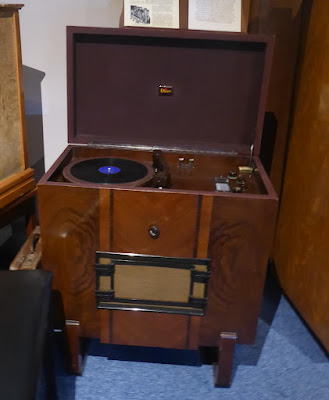The Musical Museum was founded in 1963 by a gentleman called Frank Holland (MBE) in a church on Brentford High Street. It wasn't an ideal place for such a collection, being built of poor materials that didn't give the best conditions for old instruments so, in 2007 it relocated to a purpose built building nearby which not only provided ideal conditions for the now very valuable collection but also contains an excellent concert hall.
I got this photo from Google Images - it's the purpose built building that now houses the collection. I wouldn't say is it beautiful but it serves its purpose, for sure.
Frank started collecting these at a time when many were being abandoned, thrown out or even burnt. He salvaged many of the instruments you can see there, gathering around him others who were also very interested and, as volunteers, they worked to restore these rare items to playing condition. When they moved, there was more room and so the collection grew.
Although the main purpose is restoration, the museum tries to preserve as much of the original as possible and, therefore, has instruments that will never be brought back to playing condition.
It is now a trust, helping to ensure the preservation of the collection for the future.
Basically, the museum focuses on what might be called early musical recording technology, ranging from tiny (and not so tiny) wind up musical boxes through self playing organs, pianolas and orchestrions that were wind up, clockwork or weight powered through to cylinder phonographs, an early jukebox and other electric powered items such as gramophones and stylus record players. Many of these still work and we say several demonstrated.
Domestic instruments were often driven by foot pedals - the harder the bellows are pumped, the louder the noise. I remember Dad played a bellows organ in the tiny Methodist chapel we attended as children and when he let me have a go, he had to pump the bellows because my little legs wouldn't reach!
They also have a wonderful 'Mighty Wurlitzer' which was the central instrument of the concert and is very, very impressive indeed.
Anyway - the visit. We set off on a gloriously sunny Tuesday, making good time until, as always, we hit London and then it was bumper to bumper slow until we got to Brentford which is sort of North West, further west than Hammersmith and Kensington.
So we arrived around twelve and we were greeted at the door by a couple of very welcoming staff who ushered us in and upstairs to the concert hall which was all set out with large, circular tables seating ten and the very welcome sight of coffee, tea and mince pies.
While we were enjoying these, they explained about how the visit would be organised and then we split into two groups and off we set. We focused on two rooms. One held painolas, orchestrions, musical boxes, etc, and the other had the jukebox, record players and a most intriguing thing that played two violins as well as a piany and into which one had to insert an old penny before it would start.
We heard and saw many of them working and it was such fun. The guides were so enthusiastic and so knowledgeable that it was infectious.
The only down thing was that one of our group had some sort of 'turn' and fainted with an almighty crash, She was recovering by the end of the trip but had a cut on her nose and what was going to be a magnificent black eye, poor lady. All a bit worrying but the museum's first aid routine swung into motion very efficiently and she was well looked after.
Here's some photos of what we saw in the first room
There was plenty of technical info scattered around.
Watching this one play was great fun; they have a huge collection of rolls to go with their instruments.
The juke box does work but is temperamental and while it worked for the other group, it didn't for us.
My grandparents had a gramophone thingy very similar to this one, just a little larger.
I wonder what happened to it when Nanna moved after Grampy's death in 1970. Thrown out, I expect - what a shame.
There was a big, comfortable chair in front of the one they had and I would curl up in it four hours and listen to my records or to their 78s, including 'Uncle Mac's favourite hymns for children' and party songs such as the Lambeth Walk, etc.
Thee was a screen behind and sometimes it showed words, sometimes pictures, sometimes close ups of the keyboard or the pedals and sometimes jokes to groan at.
I liked this one!
They do lots of events through the year. Several concerts, both Christmas and other, a silent panto featuring the Wurlitzer, of course, Tea Dances and so on and I believe these include a tour of the museum and refreshments.
Maybe I will come back again next year . . .
















It sounds thoroughly enjoyable and well worth a visit.
ReplyDeleteI honestly think so - it is absolutely fascinating and the food is good too! :-)
DeleteWhat a fabulous day out! Thanks for sharing. Catriona
ReplyDeleteA pleasure. It really was a lovely day. Maybe not everyone's cuppa but don't knock it until you've tried it! (I know you weren't) :-) xx
DeleteYour Musical Museum visit sounds (and looks) fantastic, and with a lovely afternoon tea thrown in. How lovely that the old gramophone stirred up such lovely family memories for you. xx
ReplyDeleteThanks, Sooze - it was great! xx
Delete